Honda CR-V
The Honda CR-V is a compact crossover SUV manufactured by Japanese automaker Honda since 1995 and introduced in the North American market in 1997.[1][2] It uses the Honda Civic platform with an SUV body design. The CR-V is Honda's mid-range utility vehicle, slotting between the smaller Honda HR-V and the larger North American market Honda Pilot. Honda states "CR-V" stands for "Comfortable Runabout Vehicle,"[3][4][5] while the term "Compact Recreational Vehicle" is used in a British car review article that was republished by Honda.[6]
| Honda CR-V | |
|---|---|
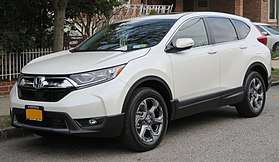 Fifth generation Honda CR-V | |
| Overview | |
| Manufacturer | Honda |
| Production | 1995–present |
| Body and chassis | |
| Class | Compact crossover SUV |
| Body style | 5-door SUV |
| Layout | Front-engine, front-wheel-drive Front-engine, four-wheel-drive |
| Chronology | |
| Predecessor | Honda Crossroad |
Honda began producing the CR-V in Sayama, Japan, and Swindon, United Kingdom, for worldwide markets, adding North American manufacturing sites in East Liberty, Ohio, United States, in 2007; El Salto, Jalisco, Mexico, in late 2007 (ended in early 2017); Alliston, Ontario, Canada, in 2012; and Greensburg, Indiana, United States, in February 2017. The CR-V is also produced in Wuhan (Hubei province) for the Chinese market by the Dongfeng Honda Automobile Company, a joint venture with Dongfeng Motor Corporation.
First generation (1996-2001)
| First generation (RD1–RD3) | |
|---|---|
 | |
| Overview | |
| Production | 1995–2001 |
| Model years | 1997–2001 |
| Assembly |
|
| Designer | Hiroyuki Kawase (1993) |
| Body and chassis | |
| Related | Honda Civic (sixth generation) Honda Integra |
| Powertrain | |
| Engine | |
| Transmission | 5-speed SBXM AWD manual 5-speed SKH FWD manual MDMA 4-speed automatic MDLA 4-speed automatic |
| Dimensions | |
| Wheelbase | 2,620 mm (103.1 in) 2,625 mm (103.3 in) (post-facelift) |
| Length | 4,510 mm (177.6 in) |
| Width | 1,780 mm (70.1 in) |
| Height | 1,678–1,770 mm (66.1–69.7 in) |
The first generation CR-V was Honda's first in-house designed sport utility vehicle by Hiroyuki Kawase. The CR-V was introduced in Japan at Honda Verno dealerships only and was regarded as a luxury vehicle in Japan due to the exterior width dimensions exceeding Japanese Government dimension regulations. For the North American market, it was displayed at the 1996 Chicago Auto Show and went on sale in February 1997.
Upon introduction, the model had only one trim level, which would later be known as the LX model trim; it was powered by the 2.0-liter straight-four B20B producing 126 hp (94 kW) at 5400 rpm and 133 lb⋅ft (180 N⋅m) of torque at 4800 rpm. Outer dimensions for this engine would be identical to the Integra's 1.8 L engine, but internally the engine had a larger 84 mm (3.3 in) bore to add the extra displacement needed to produce more torque. The engine used a one-piece cylinder sleeve construction unique from any other B-series engine. The chassis was a unibody design with fully independent suspension. The front suspension was double-wishbone, while the rear used a trailing arm-based multilink system. Inside, the rear seats were able to fold down, and a picnic table was stowed in the rear floor area. All models featured plastic cladding covering the front bumper, rear bumper, and fender wells. In most countries, CR-Vs had a chrome grille; however, in the United States, the grille was made out of the same black plastic as the bumpers. The EX included anti-lock brakes and 15 inch alloy wheels over the LX trim. Drivetrain options were front-wheel drive or Honda's Real Time AWD.
Facelift
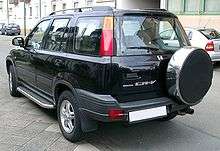
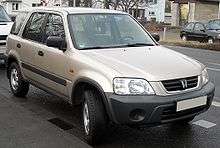
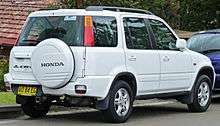
In 1999, the European, Australian and Asian CR-V models featured more drastic changes. Exterior alterations included a new front bumper, smoothed off rear bumper, and a smaller plastic radio antenna on the rear of the roof. "Nighthawk Black" was added to the list of paint choices, while "Passion Orange" disappeared. New dark blue pearl and red pearl shades replaced the former solid red and metallic blue hues. European models received an enlarged Honda emblem on the front grille, and a new metallic yellow paint in certain markets.
The engine was changed to the 2.0 L B20Z engine, producing 147 hp (110 kW) at 6200 rpm and 133 lb⋅ft (180 N⋅m) of torque at 4500 rpm. This improved performance for the 3,200 lb (1,500 kg) vehicle. Fuel economy of 23 mpg‑US (10 L/100 km; 28 mpg‑imp) city/28 mpg‑US (8.4 L/100 km; 34 mpg‑imp) highway (US) and price were not affected by the increase in power, which was the result of a higher compression ratio (9.6:1 compared to the B20B's 8.8:1), a new intake manifold, and slightly higher lift on the intake valves.
In 2000, a Special Edition model was introduced in North America. The SE featured body-colored bumpers and side moldings, a body-colored hard spare tire cover, leather upholstery, CD/cassette audio deck, rear privacy glass, a Navtech navigation system, and chrome grille accent. Until 2001, the CR-V sold more than any other vehicle in its class. The North American models also received new exterior colors including Naples Gold Metallic and Taffeta White. Electron Blue was introduced in 2000 to replace Submarine Blue Pearl, while Satin Silver Metallic replaced Sebring Silver Metallic in 2001. However, that year, sales of the Ford Escape and its clone, the Mazda Tribute, surpassed those of the CR-V.
The Australian higher specification model was called the "Sport". It was added at the time of the first facelift and included body-colored bumpers, mirrors, door handles, and hard rear spare wheel cover. It also included alloy wheels, roof rails, and a large glass sunroof. The CR-V became the country's best-selling SUV in 2000, outselling the Toyota Land Cruiser for the first time.
Safety
The 1997–2001 model tested by the Insurance Institute for Highway Safety (IIHS) was the LX model with standard driver and passenger airbags. Even though the car's structure received an acceptable rating, the overall car received a marginal rating as the dummy's left leg would have been broken. In addition to this lower body injury, the dummy's head went through the airbag which may have caused a minor concussion. The chest was well protected.
Models equipped with an automatic transmission now had an overdrive cancel button that allowed the driver to lock the transmission in the first three gears to provide power for passing and climbing grades, known as "Grade Logic." The pattern of the cloth on the seats was also redesigned, and the head restraints earned an acceptable rating from the IIHS for whiplash protection.
Second generation (2002-2006)
| Second generation (RD4–RD9) | |
|---|---|
_Sport_wagon_(2015-07-09)_01.jpg) | |
| Overview | |
| Production | 2002–2006 |
| Model years | 2002–2006 |
| Assembly |
|
| Designer | Mitsuhiro Honda (1999)[7] |
| Body and chassis | |
| Related | Honda Civic (seventh generation) Honda Element Honda Integra DC5 |
| Powertrain | |
| Engine | 2.0 L K20A1 I4 2.0 L K20A4 I4 2.2 L N22A2 turbodiesel I4 2.4 L K24A1 I4 |
| Transmission | 5-speed manual 4-speed automatic 5-speed automatic |
| Dimensions | |
| Wheelbase | 2,620 mm (103 in) 2,625 mm (103.3 in) (post-facelift) |
| Length | 4,535 mm (178.5 in) 4,600 mm (180 in) (post-facelift) |
| Width | 1,785 mm (70.3 in) |
| Height | 1,680 mm (66 in) 2002–2004 1,700 mm (67 in) 2002–2004 2WD 1,750 mm (69 in) 2002–2004 4WD 1,759 mm (69.3 in) 2005–2006 2WD 1,780 mm (70 in) 2005–2006 4WD 1,800 mm (71 in) 2005–2006 2WD/4WD |
_Sport_wagon_(2015-07-09)_02.jpg)
The second generation CR-V was a full redesign, based on the seventh generation Civic, and powered by the K24A1 engine. Southeast Asian models produced 150 hp (112 kW) of power and 190 N⋅m (140 lbf⋅ft) while the North American versions of the new engine produced 160 hp (119 kW) and 190 N⋅m (140 lbf⋅ft) of torque. Per new SAE regulations, the same North American K24A1 engine is now rated at 156 hp (116 kW) and 160 lb⋅ft (217 N⋅m). The new CR-V retained the fuel economy of the previous model because of the i-VTEC system. The new chassis had increased torsional and bending rigidity, the suspension included front toe control link MacPherson struts and a rear reactive-link double wishbone; the compact rear suspension increased cargo space to 72 cu ft (2,000 l). The second generation CR-V was Car and Driver magazine's Best Small SUV for 2002 and 2003. Second generation CR-Vs in countries outside of North America were again offered in both "low specification" and "high specification" variants, with the latter featuring body-colored bumpers and fittings. It also now did not require the glass hatch to be opened before the swinging door. Changes between model years 2002, 2003, and 2004 were minor, involving an enlargement of the center compartment bin and the addition of a front passenger door power lock in the latter two years respectively.
It is reported that in late 2003, Honda took legal action against Shuanghuan of China accusing its Laibao SRV of copying the CR-V's exterior design.[8] Production for the Laibao SRV started in 2007 and ended in 2010. Another manufacturer from China made their copy called the Tianqi Meiya TM6480A.
Facelift
In 2005, the CR-V received a mid-cycle refresh. New 16-inch wheels replaced the previous 15-inch versions. Changes included new taillights and headlights with clear indicators and two separate H1 bulbs for low beams and high beams, the previous setup used H4 single bulb for both low and high beams. The taillights now used clear lenses instead of amber for the turning indicators. The grille was also changed; it had two horizontal bars instead of one. The front bumper design was slightly changed, it now has round fog lights compared to the previous trapezium fog lights and in addition to the lower grill there are two horizontal bars instead of one. The rear bumper reflectors were longer and narrower.
_Sport_wagon_(2009-08-08)_01.jpg)
On the inside of the car, the EX trim received upgrades which included steering wheel-mounted audio controls, an outside temperature monitor and also an electric sunroof. The stereo system was also XM Satellite Radio ready (USA but not Canada). All CR-V models also had revised rear seat headrests, which had been redesigned to reduce rear view blockage.
Mechanically, the 2005 model was also changed. A major change included a drive-by-wire throttle for all CR-Vs. The all-wheel drive system was improved; it had been tuned to activate faster in low traction situations. US market models were equipped with a five-speed automatic, as opposed to the previous four-speed automatic.
In the United States and Canada, all 2005 MY and later CR-Vs have anti-lock brakes, electronic brake force distribution, traction control and Vehicle Stability Assist, front seat-mounted side airbags, and side-curtain airbags with rollover sensors for all occupants.
In Australia, the MY05 facelift went on sale in late 2004. Base models made do with only dual airbags and ABS as standard equipment, while the Sport came equipped with side airbags for the first time. Curtain airbags were unavailable on any model, until the next generation.
Following the tradition of adding a trim level above the EX during the refresh like the first generation CR-V, Honda added the SE trim level for the 2005 CR-V. The CR-V SE featured painted bumpers, body side molding, and hard, body-colored spare tire cover. For a more luxurious experience, Honda added a leather interior, leather-wrapped steering wheel, and heated side mirrors and front seats.
Australia
This iteration of CR-V arrived in Australia in January 2002, and initially came in separate guises, consisting that of the "Base" & "Sport". The "CR-V" (or "Base"), consisted of, but not limited of, dual front airbags, Air Conditioning, power windows and mirrors, as well as a CD Player. Building upon "CR-V" specification, The Sport added ABS, Cruise Control, a sunroof, 15 inch alloy wheels, front foglights, as well as body coloured bumpers and mirrors.[9] Consistently selling very well within the Medium SUV segment within the previous generation, amassing over 40,000 units between 1997 and 2001, the second generation continued its success, with it becoming the best selling SUV in 2002, selling over 12,000 units.[9]
Several "Special Edition" models were released, beginning in 2003. The "Winter Classic" & "Sport Winter Classic" were sold in Winter/Spring 2003. Building upon the "Base", Winter Classic added alloy wheels, side steps, as well as a Tow Bar, whilst the Sport Winter Classic gained roof racks, nudge bar and foglights, however, did without the towbar. Later within this iteration, in 2005, an SE model was launched, featuring Rear parking Sensors, nudge bar and 16' alloy wheels. It was sold between October and November 2005. Running throughout 2006, the CR-V "Extra" brought with it 16 inch alloy wheels and side airbags.[10]
The following table lists its sales throughout its tenure
| Year | Australia |
|---|---|
| 2002 | |
| 2003 | 9,736 |
| 2004 | >8,078 |
| 2005 | 8,844 |
| 2006 | |
| 2007 (Jan-Feb) | |
Third generation (2007-2011)
_Sport_wagon_01.jpg)
The third generation CR-V went on sale in the U.S. in late September 2006 for the 2007 model year. Unlike preceding models, it features a rear liftgate rather than a side-opening rear door and no longer has the spare tire mounted on the rear door.
The third generation CR-V is powered by Honda's standard K-series 2.4 L inline-four engine. In North American markets, this engine's power is rated at 166 hp (124 kW) at 5,800 rpm and 161 lb⋅ft (218 N⋅m) at 4,200 rpm.[11] A 2.2 L i-CTDI diesel engine was offered in the European and Asian markets. The European market CR-V had the R20A 2.0 L gasoline engine, based on the Honda R-series i-VTEC SOHC engine found in the Honda Civic, as opposed to the previous CR-V offering the K20A.
Facelift
_%E2%80%93_Frontansicht%2C_16._April_2011%2C_D%C3%BCsseldorf.jpg)
For the 2010 model year, the CR-V received style, powertrain and equipment changes. Changes included a redesigned front fascia with a new horizontal-slat chrome grille and honeycomb-designed lower front grille, new front bumper, and revised tail lights. The rear bumper was redesigned, as well as new five split-spoke 17-inch alloy wheels for EX and EX-L models. The interior received minor changes, including seat fabrics, as well as wider driver and front-passenger armrests. The audio head unit controls were altered and the information display backlighting in the gauges was changed to blue, instead of the previous black. A USB audio input became standard in the EX-L trim while hands-free Bluetooth connectivity was exclusive to the EX-L trim equipped with navigation system. In 2011, a mid-level SE trim debuted with a 6-disc CD changer and 17-inch 7-spoke alloy wheels that came from the pre-facelift EX and EX-L trims.
Fourth generation (2011-2016)
_VTi_2WD_wagon_(2015-08-07)_01_(cropped_II).jpg)
The CR-V Concept debuted at the Orange County International Auto Show in September 2011,[12] the production 2012 CR-V debuted at the 2011 Los Angeles Auto Show.[13] The CR-V went on sale in the U.S. on 15 December 2011.[14]
It is powered with a 2.4-liter i-VTEC inline-four engine that puts out 185 hp and 163 pound-feet (220 Nm) of torque at 4,400 rpm along with an all-new Real-Time all-wheel-drive (AWD) with intelligent control system. All North American CR-Vs come equipped with a 5-speed automatic transmission.[15]
Facelift
_VTi_2.0_2WD_wagon_(2018-10-08)_01.jpg)
The facelifted 2015 model year CR-V went on sale during October 2014.[16] The CR-V uses the direct injected Earth Dreams engine and continuously variable transmission (CVT) transmission combination first introduced on the ninth generation Accord, EPA estimated fuel economy is improved +4/+3/+3 mpg (city/highway/combined). The structure has been modified to improve crash performance, particularly in the IIHS's small offset crash test. The suspension shock absorbers, springs, anti-roll bars and lower control arms are also revised to improve ride performance, while a reduced 15.6:1 steering gear ratio and larger brake booster gives it a sportier feel.
Fifth generation (2017-Present)
| Fifth generation (RW1–RW6, RT5–RT6) | |
|---|---|
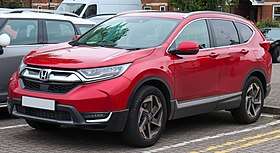 2019 Honda CR-V EX (RW1; pre-facelift, UK) | |
| Overview | |
| Also called | Honda Breeze (China, Guangqi Honda)[17][18] |
| Production | November 2016–present |
| Model years | 2017–present |
| Assembly |
|
| Body and chassis | |
| Related | Acura CDX Honda Civic (tenth generation) |
| Powertrain | |
| Engine | |
| Transmission | CVT 9-speed ZF automatic (diesel) |
| Dimensions | |
| Wheelbase | 104.7 in (2,659 mm)[19] |
| Length | 180.6 in (4,587 mm) |
| Width | 73.0 in (1,854 mm) |
| Height | 66.1 in (1,679 mm) (FWD) 66.5 in (1,689 mm) (AWD) |
| Curb weight | 1,500–1,540 kg (3,307–3,395 lb) (FWD) 1,551–1,593 kg (3,419–3,512 lb) (AWD) |
%2C_South_Tangerang.jpg)
%2C_Batu_City.jpg)
_%2BSport_2WD_wagon_(2018-10-22)_01.jpg)
_%2BSport_2WD_wagon_(2018-10-22)_02.jpg)
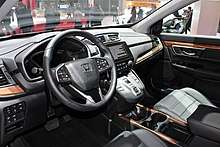
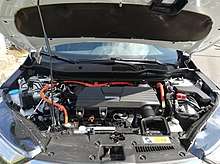
The fifth generation CR-V was unveiled on 13 October 2016 in Detroit. Sales began in the U.S. on 21 December 2016 as a 2017 model year. It uses the same Honda compact global platform introduced on the tenth generation Civic. Honda began producing the CR-V at East Liberty, Ohio (ELP) in November 2016[20] and at Greensburg, Indiana (HMIN) during February 2017.[21][22] The driver's seat adds a 4-way power lumbar option. The fifth generation of CR-V is available in 5-seater and 7-seater variant.
The base engine is an Earth Dreams 2.4-liter I-4 engine with 184 hp (137 kW; 187 PS), a turbocharged 1.5-liter I-4 with 190 hp (142 kW; 193 PS) is offered. The turbocharged engine delivers peak torque at 2,000 rpm-5,000 rpm[23] whereas the naturally-aspirated engine delivers its peak torque at 3,900 rpm.[24] U.S. and Canada models are only available with continuously variable transmission. For the 2020 model year, Honda has made the 1.5-liter engine standard on all CR-V trim levels sold in the United States.[25] In several markets, the CR-V is also available with a 1.6-liter Honda i-DTEC turbodiesel option, producing 160 hp (119 kW; 162 PS) paired to a ZF 9HP transversely-mounted 9-speed automatic transmission. The i-DTEC turbodiesel engine has been revised from having a single variable-nozzle turbocharger in the earlier version to having two turbochargers - one for low RPMs and the other for high RPMs - to minimise turbo lag. It uses an aluminum cylinder head paired to an open-deck cylinder block, with shorter and thinner piston skirts to reduce mechanical friction to levels comparable to a gasoline engine.[26]
The Honda Sensing package, which includes features like Adaptive Cruise Control (ACC), Collision Mitigation Braking (CMBS) and Lane Keeping Assist (LKAS), are standard on EX and above trims; the package was formerly reserved to the Touring trim prior to the fifth generation release. New safety features introduced include: Blind Spot Information (BSI) with Rear Cross Traffic Monitor (CTM), replacing the LaneWatch system from the previous generation CR-V, and Auto High Beam (HSS) headlights. Honda Sensing is standard on all CR-V trim levels for 2020 and adds traffic sign recognition.[27]
LED daytime running lights, 18" alloy wheels and electronic parking brake with a new auto-hold feature are available. Additional, new features include a power lift-gate, active grille shutter system to reduce aerodynamic drag, Android Auto/Apple CarPlay on a 7-inch touch screen display with volume knob, 7-inch TFT instrument display and LED headlights.[28]
The fifth generation CR-V was also launched in Thailand on 24 March 2017 and in Indonesia on 27 April 2017 at the 25th Indonesia International Motor Show. Indonesian models went on sale on 17 June 2017. The Indonesian model top trim (Prestige) is equipped with 5-spoke 18-inch Modulo alloy wheels not seen in other markets.
In the Philippines, the 1.6-liter i-DTEC diesel engine manages 120 PS and 300 Nm of torque.[29]
The CR-V Hybrid was unveiled at the 2017 Auto Shanghai in China during April 2017.
The fifth generation CR-V was also launched in Japan on 30 August 2018 and went on sale on the following day, making it the return of the CR-V for the Japanese domestic market after a two-year hiatus since the fourth generation CR-V was discontinued there in August 2016. It was previously displayed on 27 October 2017 at the 2017 Tokyo Motor Show, announced on 29 September 2017.
In 2017, Honda Malaysia launched the fifth generation CR-V with four trim levels[30][31]. After two years launch of the new fifth generation Honda CR-V, Honda Malaysia just launch the fifth generation Honda CR-V Mugen Limited Edition.[32]
Facelift
Honda unveiled a refreshed CR-V on 18 September 2019. The refreshed model will be the first CR-V to be sold in North America with a hybrid powertrain. The CR-V Hybrid will feature a 2.0L Atkinson-Cycle I4 gasoline engine with Honda's Integrated Motor Assist (IMA) System. The vehicle will be assembled at Honda's Greensburg, Indiana assembly plant (which also produces the standard gasoline-only CR-V) and the powertrain will be assembled in Anna, Ohio. The previously-available 2.4-liter naturally-aspirated I4 gasoline engine that powered the base LX trim has been dropped from the CR-V lineup for 2020, as all CR-V models (except for the CR-V Hybrid) will now be powered by the 190-horsepower, 1.5-liter turbocharged I4 gasoline engine. All CR-V's use a CVT and are available with FWD or Honda's Real Time 4WD system. The gasoline-only CR-V went on sale at Honda dealerships across North America starting in late fall 2019, while the CR-V Hybrid will go on sale in early 2020 and compete with other models such as the Toyota RAV4 Hybrid and Ford Escape Hybrid.
Other changes for the 2020 CR-V include larger nineteen-inch (19") alloy wheels on top-line Touring models, redesigned eighteen-inch (18") alloy wheels for EX and EX-L trims, a revised front fascia with a new upper grille (which also features a blue-outlined Honda 'H' emblem on CR-V Hybrid models), revised side skirts with chrome inserts, a new rear bumper with chrome insert, a pushbutton-controlled CVT for CR-V Hybrid models, LED front fog lamps on most models (except on the base LX trim), new exterior color options and standard "Honda Sensing" driver assistance technology for all models.[33] The 2020 CR-V starts out at $25,150 for the base model LX, and can cost as much as $36,050 for the Hybrid Touring trim. [34]
The Chinese market variant with different front and rear fascias is called the Honda Breeze, which is produced and sold by Guangqi Honda and was launched on 18 October 2019.[35]
%2C_front_3.2.20.jpg) Honda CR-V (facelift)
Honda CR-V (facelift)%2C_rear_3.2.20.jpg) Honda CR-V (facelift)
Honda CR-V (facelift) Honda Breeze Hybrid (China)
Honda Breeze Hybrid (China)
Engines
| Engine | Horsepower | Torque |
|---|---|---|
| 2.4L I4 | 184 hp (137 kW) at 6,400 rpm | 180 lb⋅ft (240 N⋅m) at 3,900 rpm |
| 1.5L I4 Turbo | 190 hp (140 kW) at 5,600 rpm | 179 lb⋅ft (243 N⋅m) at 2,000-5,000 rpm |
| 2.0L l4 Petrol | 151 hp (113 kW) at 6,500 rpm | 139 lb⋅ft (188 N⋅m) at 4,300 rpm |
| 2.0L I4 Hybrid | 212 hp (158 kW) combined gas and electric | 129 lb⋅ft (175 N⋅m) gas, 232 lb⋅ft (315 N⋅m) electric; 232 lb⋅ft (315 N⋅m) combined. [36][37] |
| 1.6L I4 Turbodiesel | 160 hp (120 kW) at 4,000 rpm | 258 lb⋅ft (350 N⋅m) at 2,000 rpm |
Safety
| Overall: | |
| Frontal Driver: | |
| Frontal Passenger: | |
| Side Driver: | |
| Side Passenger: | |
| Side Pole Driver: | |
| Rollover FWD: | |
| Rollover AWD: |
| Euro NCAP test results | ||
|---|---|---|
| CR-V (2019)[39] | ||
| Test | Points | % |
| Overall: | ||
| Adult occupant: | 35.7 | 93% |
| Child occupant: | 40.7 | 83% |
| Pedestrian: | 33.6 | 70% |
| Safety assist: | 9.9 | 76% |
| Vehicle Category | SUV | |
|---|---|---|
| Number Of Airbag | 6 | |
| Score | Rating | |
| Overall | 88.80/100.00 | |
| Adult Occupant Protection | 34.02/36.00 | |
| Frontal Impact | 14.76/16.00 | |
| Side Impact | 16.00/16.00 | |
| Head Protection Technology | 3.26/4.00 | |
| Child Occupant Protection | 44.76/49.00 | |
| Frontal Impact | 15.65/16.00 | |
| Side Impact | 8.00/8.00 | |
| Safety Assist | 13.47/18.00 | |
| Effective Braking & Avoidance | 8.00/8.00 | |
| Seatbelt Reminders | 3.00/6.00 | |
| Blind Spot Technology | 0.47/2.00 | |
| Advanced SATs | 2.00/2.00 | |
Sales
| Calendar year | Sales[41] |
|---|---|
| 1997 | 66,752 |
| 1998 | 100,582 |
| 1999 | 120,754 |
| 2000 | 118,260 |
| 2001 | 118,313 |
| 2002 | 146,266 |
| 2003 | 143,909 |
| 2004 | 149,281 |
| 2005 | 150,219 |
| 2006 | 170,028 |
| 2007 | 219,160 |
| 2008 | 197,279 |
| 2009 | 191,214 |
| 2010 | 203,714 |
| 2011 | 218,373 |
| 2012 | 281,652 |
| 2013 | 303,904 |
| 2014 | 335,019 |
| 2015 | 345,647 |
| 2016 | 357,335 |
| 2017 | 377,895 |
| 2018 | 379,013 |
| 2019 | 384,168 |
Other markets
| Calendar Year | Canada[42] | Europe[43] | China | Thailand | Indonesia[44] | |
|---|---|---|---|---|---|---|
| CR-V[45] | Breeze | |||||
| 1997 | 16,022 | |||||
| 1998 | 37,975 | |||||
| 1999 | 34,793 | |||||
| 2000 | 29,129 | |||||
| 2001 | 23,373 | |||||
| 2002 | 30,854 | |||||
| 2003 | 31,443 | |||||
| 2004 | 15,388 | 33,029 | 9,301 | |||
| 2005 | 15,976 | 49,739 | 26,243 | 7,694 | ||
| 2006 | 17,821 | 43,258 | 23,672 | 1,864 | ||
| 2007 | 20,980 | 76,613 | 45,688 | 15,750 | ||
| 2008 | 20,500 | 55,107 | 80,607 | 17,800 | ||
| 2009 | 18,554 | 42,437 | 102,745 | 10,110 | ||
| 2010 | 24,930 | 38,781 | 140,000 | 16,961 | ||
| 2011 | 25,076 | 36,088 | 160,003 | 11,760 | ||
| 2012 | 33,339 | 37,182 | 169,037 | 14,753 | ||
| 2013 | 34,481 | 47,596 | 199,333 | 20,385 | ||
| 2014 | 37,684 | 49,182 | 168,184 | 8,393[46] | 8,551 | |
| 2015 | 38,961 | 46,967 | 156,608 | 7,802[47] | 10,750 | |
| 2016 | 44,789 | 43,456 | 180,319 | 3,487[48] | 7,853 | |
| 2017 | 50,433 | 34,616 | 181,177 | 11,232[49] | 15,905 | |
| 2018 | 54,879 | 28,576 | 143,689 | 11,672[50] | 14,565 | |
| 2019 | 55,859 | 32,929 | 213,306 | 9,007 | 10,933[51] | 10,395 |
References
- "Honda CR-V Model Details". NADAguides. Retrieved 15 March 2018.
Debuting in Japan for the 1996 model year, the five-passenger compact utility vehicle Honda CR-V was introduced to North America in early 1997.
- Stein, Jason (17 July 2005). "GM planning to beef up its lineup of small sport wagons by '08". Autoweek. Automotive News. Retrieved 15 March 2018.
since the 1996 U.S. debut of the RAV4. The Honda CR-V hit the market a year later.
- "Honda Announces a Full Model Change for the CR-V" (Press release). Honda Worldwide. 18 September 2001. Retrieved 5 August 2017.
The initials CR-V stand for "Civic Recreational vehicle". But lately it's been known as a QUV in areas like California and along the west coast in USA.
- "Fact Book: Press Information CR-V Concept" (Press release) (in Japanese). Honda Japan. 18 September 2001. Retrieved 15 March 2018.
心地よく自由に走り回れる乗り物"=Comfortable Runabout Vehicle
- "Cr-v 1995.10". Fact Book: Press Information (Press release) (in Japanese). Honda Japan. 9 October 1995. Retrieved 10 January 2018.
Comfortable Runabout Vehicle «CR-V»
- Simister, John (15 September 2012). "It's a better CR-V in every way..." The Independent. London. Retrieved 10 January 2018.
This is Honda's fourth car to wear the CR-V initials that stand for Compact Recreational Vehicle.
Republished as "It's a better CR-V in every way..." (Press Reviews). Honda UK. 16 September 2012. Retrieved 10 January 2018. - Archived 2015-11-17 at the Wayback Machine
- "Lawsuits". Ortaffa, France: China Motor Vehicle Documentation Centre. Archived from the original on 23 July 2011.
- Newton, Bruce (10 December 2001). "First Oz drive: Honda CR-V evolves". GoAuto. Retrieved 22 April 2019.
- "Previous Models: CR-V: 2002 - Current". Honda Australia. 2 February 2007. Retrieved 22 April 2019.
- "2007 Honda CR-V Specs". JB car pages. Retrieved 24 July 2008.
- Lienert, Anita (22 September 2011). "2012 Honda CR-V Concept Debuts 22 Sep 2011". Insideline.com. Retrieved 21 November 2012.
- "All-new Honda CR-V debuts at LA Auto Show".
- Lienert, Paul (17 November 2011). "2012 Honda CR-V Is Redesigned: 2011 Los Angeles Auto Show". Insideline.com. Retrieved 21 November 2012.
- "Award-Winning 2014 Honda CR-V Goes On Sale Today, is an Efficient and Compact SUV Loaded with Value, Versatility and Features" (Press release). American Honda Motor Company. 6 August 2013. Retrieved 31 May 2014.
- "Honda Reveals New 2015 CR-V" (Press release). 22 September 2014. Archived from the original on 6 October 2014. Retrieved 22 September 2014.
- Lye, Gerald (15 August 2019). "Honda Breeze for China – CR-V body with Accord face".
- "2020 Honda Breeze SUV is bigger than CRV – Gets front styling from Accord". 15 August 2019.
- "2017 CR-V [Preliminary] Specifications & Features". Honda. 13 October 2016. Retrieved 17 September 2017.
- "Honda Begins Production of All-New 2017 CR-V in Ohio; First-ever Global Production Launch for East Liberty Plant" (Press release). American Honda Motor Company. 22 November 2016. Retrieved 20 June 2019.
- "Honda to Add Production of Best-selling CR-V in Indiana" (Press release). American Honda Motor Company. 11 January 2016. Retrieved 2 March 2018.
- "Honda Begins First Production of SUVs in Indiana with 2017 CR-V" (Press release). American Honda Motor Company. 15 February 2017. Retrieved 20 June 2019.
- Snavely, Brent (13 October 2016). "Honda reveals all-new CR-V in Detroit". Detroit Free Press. Retrieved 13 October 2016.
- "2017 Honda CR-V: Product & Performance Overview". Automoblog. 28 February 2017. Retrieved 1 March 2017.
- Capparella, Joey (18 September 2019). "2020 Honda CR-V Adds a Hybrid Model and Gets a New Look". Car and Driver. Retrieved 28 December 2019.
- "The new 1.6L i-DTEC Honda engine". Car-engineer.com. 28 November 2014. Retrieved 17 September 2017.
- Abuelsamid, Sam (13 October 2016). "2017 Honda CR-V: More Of Everything, Including A Volume Knob!". Forbes. Retrieved 13 October 2016.
- "Bold and Sophisticated Styling and Turbo Engine Power Restate the All-New 2017 Honda CR-V as the Outright Benchmark Compact SUV" (Press release). American Honda Motor Company. 13 October 2016. Retrieved 17 September 2017.
- "Honda Cars Philippines › CR-V".
- "2017 Honda CR-V fifth-generation Malaysia". 12 July 2017. Retrieved 31 July 2017.
- "2017 Honda CR-V – top of the class, again". 15 November 2017. Retrieved 16 November 2017.
- "Honda CR-V Mugen Limited Edition Malaysia 2019 only 300 units available". 19 July 2019. Retrieved 31 July 2019.
- "2020 Honda CR-V: America's Most Popular CUV Gets New U.S.-Built Hybrid-Electric Version, Standard Honda Sensing® and Freshened Styling" (Press release). American Honda Motor Company. 18 September 2019.
- "2020 CR-V Specifications and Features". Honda Automobiles. Retrieved 23 July 2020.
- Ansari, Usman (18 October 2019). "All New Honda Breeze Launched in China". CarSpiritPK. Retrieved 31 December 2019.
- https://www.motortrend.com/cars/honda/cr-v-hybrid/2020/2020-honda-cr-v-hybrid-first-drive/
- https://www.caranddriver.com/reviews/a31679395/2020-honda-cr-v-hybrid-drive/
- "2017 Honda CR-V SUV AWD". NHTSA. Retrieved 17 September 2017.
- "Official Honda CR-V 2019 safety rating". Retrieved 27 February 2019.
- "HONDA CR-V (2017)". Aseancap. 15 August 2017. Retrieved 30 June 2020.
- "Honda 2019 Digital FactBook". Honda North America. Retrieved 19 August 2019.
- "Honda CR-V Sales Figures". GCBC. Retrieved 27 February 2020.
- "Honda CR-V European sales figures". carsalesbase.com. Retrieved 10 August 2019.
- "Indonesia Sales Figures".
- "Honda CR-V China auto sales figures".
- "Thailand cars sales report 2014". HeadlightMag.com. Thailand. Retrieved 24 October 2018.
- "Thailand cars sales report 2015". HeadlightMag.com. Thailand. Retrieved 24 October 2018.
- "Thailand cars sales report 2016". HeadlightMag.com. Thailand. Retrieved 24 October 2018.
- "Thailand cars sales report 2017". HeadlightMag.com. Thailand. Retrieved 24 October 2018.
- "Sales Report เจาะลึกยอดขายรถยนต์ ธันวาคม 61 + สรุปปี 2018 แบ่งตาม Segment". HeadLight Magazine (in Thai). 9 May 2019. Retrieved 10 August 2019.
- "Sales Report ยอดขายรถยนต์ กลุ่ม Compact SUV (C-SUV) : เดือน มกราคม – ธันวาคม 2019". HeadLight Magazine (in Thai). 12 February 2020. Retrieved 12 February 2020.
External links
| Wikimedia Commons has media related to Honda CR-V. |
- CR-V at Honda Worldwide
- CR-V New Zealand Model
- CR-V Australia Model
- CR-V US Model
- CR-V UK & IRELAND Model